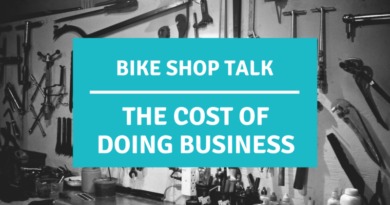How Minx-Girl.com rode the dot com bubble & changed perceptions
The internet’s effect on cycle retail goes beyond the clichéd ‘bricks and mortar vs online’ view. Duncan Moore speaks with Debbie Burton, Minx-Girl founder…
Much has been written about how the internet is to blame for the demise of the LBS. But to accept that point of view is to miss many important points and one great illustration of this is the story of Minx-Girl.com; a website that rode the dot com bubble, helped to change people’s perceptions and suffered from the pressure of larger operations.
In the late ‘90s, the mountain bike boom was in full swing, more and more people were getting into cycling and more and more independent cycle stores were opening up. However, a common theme among not only the newcomers but existing stores too was a failure to acknowledge the existence of women riders. One of those riders who felt ignored was Debbie Burton. Burton is a life-long cyclist, who like many riders first discovered cycling through the then-new craze of mountain bikes.
Always an early adopter she describes her cycling CV as “mountain biking since it started, one of the first into triathlon, trying ‘cross racing before it became the thing. I wasn’t good at any of them, I always finished mid-pack in a tri, bottom half of an MTB race and dead flat last in ‘cross. The point is not that I was some brilliant cyclist who decided to carve her own trail but that I was an enthusiast who just loved riding a bike.”
It was that enthusiasm that would form the catalyst for what would go on to become a revelation for so many other women on bikes. Like her fellow riders at the time Burton struggled to find riding kit. “I knew people in the business (my other half is cycling photographer Russell Burton, who started in bike retail) and when I asked why the offering of women’s clothing was so poor they always said there was never enough demand and what there was, was difficult to meet because everyone wanted something different. “On the other hand, women who might have found something they wanted to try on found bike shops without changing rooms, or the changing room was the loo (nice) and once they wriggled into the garment the sizing was like nothing else on the high street.”
These were not the only issues Burton had to deal with while trying to buy kit at that time as she explains it was not just the lack of options but “at that time [the late-‘90s] female specific shorts, if you could find any, were cheap, shiny and the most unflattering garments anyone bothered to invest money in stitching together. There were few good women’s jerseys so my friends and I mostly bought men’s.”
However, Burton was in the fortunate position that her career in sports buying, including technical apparel development and range building with some marketing and a lot of trend forecasting along the way, meant she travelled a lot. One of her most common destinations was the US and that proved to be a godsend for her. “I bought most of my cycling kit in the USA where there was more choice.” The arrival of her daughter in 2001 meant Burton had to put her career on hold and with it the chance to buy decent cycling kit overseas. With time on her hands, Burton started to consider online shopping as a way of getting what she wanted – not just for herself but for others too.
“Online shopping was just beginning but everyone was still very nervous about it. There had been some memorable over-invested businesses going bust before they even launched properly and horror-stories of people shopping on dodgy sites and never seeing their goods. But it was something I kept coming back to. “Net-a-Porter was somehow starting to make a success of selling luxury clothing online and everyone said that couldn’t be done either, so with that in mind I made a plan,” says Burton about the catalyst for what was to become Minx-Girl. The plan that she came up with was a website specifically for women cyclists, neatly side-stepping the problem of a fragmented market. As she says: “What would result in sales of just one pair of shorts per store in different locations across the country (and therefore not worth stocking) would actually be worthwhile multiple sales for one online shop.”
However, the site’s real USP was that it would only sell functional female-specific items. Other points taken into account at the planning stage included ensuring the experience of visiting the site was as much fun as shopping for other clothes, “lust-worthy product that inspired an emotional WANT. It had to give the same amount of joy when you tried it on as a new party top. Not the ‘It’ll do then….’ that was the usual response to buying bike kit because it didn’t look that great but at least it was SOMETHING.” Expanding further on how she took her own bike shop experiences and turned them on their head, Burton says: “Everyone knows shopping is always better with a best friend who will be honest about what suits you and doesn’t. As an antidote to the horrible retail trying-on experience, Minx would always be on hand to give you the heads-up on what would work and what wouldn’t depending on your body shape. Hence the ‘looks great on sporty thighs’ or ‘comfy on post-cake tums’ copy.”
Many of the points that Burton incorporated into Minx-Girl were simply done on instinct but she now notes that “many of these things have become part of creating a great user experience. Someone once commented that it was the perfect coming together of all my work experience combined with a gap in the market. Truthfully, we were a little ahead of the market because it was maybe another five years before women’s cycling really started to take off, but ironically we made our best gains when it was more niche. “When I started the balance was definitely towards mountain biking and we tapped into the early commuting trend by providing clothes that didn’t mind being sweated in on a bike but looked like ‘ordinary’ clothes off it.
Gradually as more women got into road cycling I went in search of properly female-specific chamois, shorts that didn’t turn thighs into sausages. It was always about delivering functionality but in a way that riders could bear to be seen in.” However, it was that very change that began to impact upon the success of the Minx-Girl website. “As the market was shifting in end use and women’s cycling was growing in profile so distribution patterns started to change,” explains Burton. “Some of the niche independent brands I had discovered in the US saw the opportunity in the UK and moved to a distribution rather than direct model. Good business for them but brands previously exclusive to Minx were suddenly more widely available and often on discounted promotion. This, by the way, is not exclusive to the cycling industry, it has happened with every brand I have ever worked with, it’s part of the product cycle. Niche brands are discovered by independent retailers who make them cool. They get onto the radar of distributors, multiple retailers and today, bigger online platforms who can afford to buy higher volumes. It’s great for the brands’ growth and I’ve never come across one who can manage that balance but it means that independents have to remain agile.
“Some of the more ‘mainstream’ brands I worked with also changed from direct to distributor supply – that meant some of the products Minx had done well with were not always available as the volumes weren’t high enough for the distributor to consider making them part of the UK line. “There was a tough year while this played out but I took Minx back to her roots of working with exclusive women-only brands that were delivering something different to the women’s cycling market and growth returned.”
When Burton began Minx-Girl, Burton started it with the expectation that it would supplement a freelance income, but within a year it was a full time job. “It grew to such a point that I had to decide to either look for outside investment or consciously remain small. I looked at going bigger but it was always hard to see how Minx would scale, I hadn’t started it to have an empire, I decided to keep it niche.
“Gradually my other freelance work changed and I found myself working within businesses again and enjoying it. Balancing my commitments became harder and eventually I decided in 2016 that the women’s cycle clothing market had changed enough that there was a lot of choice out there – my initial work was done and therefore my lovely Minx customers would forgive me if I took a break before I broke.”
That break became permanent but the legacy of Burton’s work bringing new women’s clothing brands and women’s options from existing brands to the UK market and changing the way retailers think about how they stock, display and ultimately sell that kit remains.



